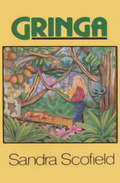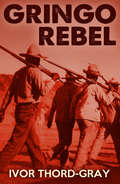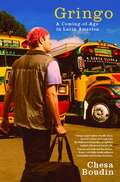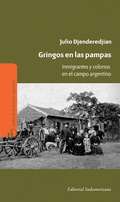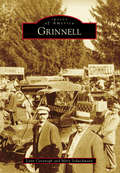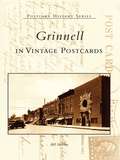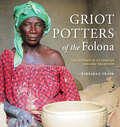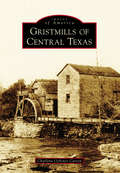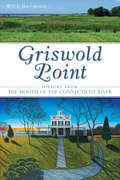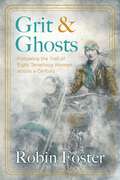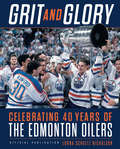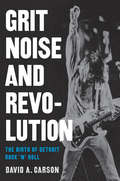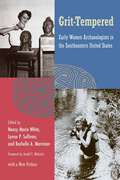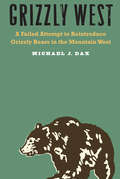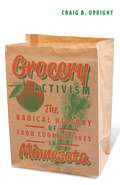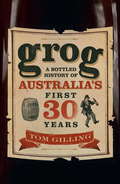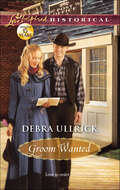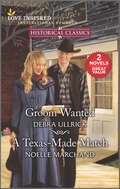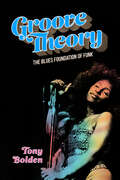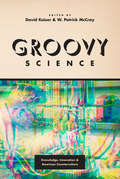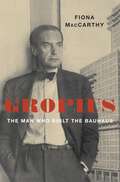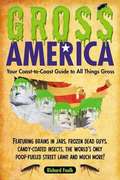- Table View
- List View
Gringa
by Sandra ScofieldThis is a novel about Abilene Painter, a young woman with a drab Texas past whose fate leads her to Mexico. Here she becomes the mistress of a powerful bullfighter and rancher, Antonio Velez. Abilene is a study in the pathology of passivity, a woman who has never thought she&’s had real choices. She toys with risk, playing games with men who belong to Tonio. It is also 1968, a time of student uprisings and massive demonstrations in Mexico City. Abilene, seduced by the danger, walks a fine line.
Gringo Rebel
by Ivor Thord-GrayGringo Rebel, first published in 1960, is the account of Swedish-born adventurer Ivor Thord-Gray of his time in 1913-1914 in revolutionary Mexico. Thord-Gray first served as an artillery officer in Francisco 'Pancho' Villa’s forces, and later served as a cavalry officer in Carranza’s army under Obregón. He formed close bonds with his Yaqui and Tarahumara scouts, and later prepared a Tarahumara-English Dictionary, and other books about Mexican archaeology. Gringo Rebel offers a first-hand look at the poorly understood conflict in Mexico between the wealthy ruling class and the large majority of land-less peasants living in slave-like conditions, as well as insights into rebel leaders such as Pancho Villa and Emiliano Zapata (leader of the 'Zapatistas'). Seventeen pages of illustrations are included in this new edition.
Gringo Viejo
by Carlos FuentesDuring the years of intense revolutionary struggle in Mexico, an old North American writer heads south of the border in search of his destiny.
Gringo: A Coming of Age in Latin America
by Chesa BoudinGringo charts two journeys, both of which began a decade ago. The first is the sweeping transformation of Latin American politics that started with Hugo Chavez's inauguration as president of Venezuela in 1999. In that same year, an eighteen-year-old Chesa Boudin leaves his middle-class Chicago life -- which is punctuated by prison visits to his parents, who were incarcerated when he was fourteen months old for their role in a politically motivated bank truck robbery -- and arrives in Guatemala. He finds a world where disparities of wealth are even more pronounced and where social change is not confined to classroom or dinner-table conversations, but instead takes place in the streets.
Gringos en las pampas: Inmigrantes y colonos en el campo argentino
by Julio DjenderedjianDe la colección Nudos de la Historia argentina, todas las respuestasacerca de la inmigración en la Argentina. ¿Qué fue lo que llevó a millones de hombres y mujeres de todo el mundo amigrar a la Argentina, hace ya más de un siglo? ¿Cómo se enteraron deque existía ese país campesinos que muchas veces no sabían leer y nuncahabían salido de su aldea natal? ¿De qué modo viajaron, trabajaron yvivieron en su nuevo hogar? ¿Cómo lograron adaptarse a un medio tandistinto del que provenían? Este libro aborda la compleja historia deesos hombres y mujeres, que se atrevieron a desafiar la incertidumbre deirse al otro lado del mundo abandonando familia, amigos y todo lo quemás querían, para poder cumplir un sueño. El sueño de trabajar duro perono en vano; de poder contar con que su esfuerzo les permitiera ahorrar,asegurar su futuro y educar a sus hijos. Muchos de esos inmigrantes setransformaron en colonos: fueron al campo, a poblar la inmensidad de laspampas, a arrastrar el arado desde antes de la salida del sol, acultivar, sembrar y cosechar. Aquí se narra cómo fue que, con sutrabajo, fundaron pueblos y ciudades, renovaron las formas de producir,dieron valor a las tierras y lograron que la Argentina se convirtiera,en sólo unas pocas décadas, en uno de los principales productoresmundiales de alimentos.Para la colección Nudos de la Historia argentina hemos pedido ahistoriadores de primer nivel que escriban libros sólidos pero a la vezatractivos, susceptibles de ser leídos y disfrutados por personasinteresadas en la historia, aunque carezcan de una formaciónuniversitaria en la disciplina. Esperamos estar a laaltura del desafío.
Grinnell
by Mary Schuchmann Lynn CavanaghA passion for education, opposition to slavery, and yearning for a moral life led Josiah B. Grinnell and his band of like-minded New Englanders to establish a town and a college on the Iowa prairie in 1854. Over the years, a remarkable number of dreamers and doers from all walks of life have emerged from Grinnell, including pioneer aviator Billy Robinson; Harry Hopkins, advisor to Pres. Franklin D. Roosevelt; and Robert Noyce, cofounder of Intel Corporation. Today, Grinnell is a distinctive blend of urban and rural culture that has been marked by the idealism of its beginnings, molded by the surrounding agricultural economy, and shaped by prestigious Grinnell College. Proudly known as the "Jewel of the Prairie," Grinnell is recognized in the National Register of Historic Places with two historic districts and 15 individual buildings. The Merchants National Bank designed by Louis Sullivan is a National Historic Landmark.
Grinnell in Vintage Postcards
by Bill MennerFrom an abolitionist hotbed to the home of a prestigious liberal arts college, Grinnell, Iowa, is known across the country as a "jewel of the prairie." Originally conceived as a Congregationalist utopia, Grinnell developed a reputation as a highly-educated community with a wealth of incredible architecture. It was also a turn-of-the-century industrial hub, despite a population of less than 5,000, where buggies, early automobiles, and gloves were made.The historic postcards in this book recall a community on the verge of transition, from a small agriculture-based town on the prairie to a thriving center of commerce and higher education. They provide a remarkable glimpse of the buildings that make up what is now a "Historic Commercial District" on the National Register of Historic Places. Still others are visual reminders of great buildings-both in the community and on the Grinnell College campus-that now exist only in memory.
Griot Potters of the Folona: The History of an African Ceramic Tradition
by Barbara E. FrankGriot Potters of the Folona reconstructs the past of a particular group of West African women potters using evidence found in their artistry and techniques. The potters of the Folona region of southeastern Mali serve a diverse clientele and firing thousands of pots weekly during the height of the dry season. Although they identify themselves as Mande, the unique styles and types of objects the Folona women make, and more importantly, the way they form and fire them, are fundamentally different from Mande potters to the north and west.Through a brilliant comparative analysis of pottery production methods across the region, especially how the pots are formed and the way the techniques are taught by mothers to daughters, Barbara Frank concludes that the mothers of the potters of the Folona very likely came from the south and east, marrying Mande griots (West African leatherworkers who are better known as storytellers or musicians), as they made their way south in search of clientele as early as the 14th or 15th century CE. While the women may have nominally given up their mothers' identities through marriage, over the generations the potters preserved their maternal heritage through their technological style, passing this knowledge on to their daughters, and thus transforming the very nature of what it means to be a Mande griot. This is a story of resilience and the continuity of cultural heritage in the hands of women.
Gristmills of Central Texas (Images of America)
by Charlene Ochsner CarsonGristmills were once commonplace in Texas. There was hardly a river, a creek, or a stream without one. The purpose of the gristmill was to grind wheat into flour and corn into meal. Prior to the water-powered gristmill, grinding was a tedious, time-consuming task that was usually performed by hand using some type of mortar and pestle. When a gristmill began operating in an area, settlers from near and far traveled to the mill to have their grain ground. The gathering of these settlers and farmers at the mill was the beginning of many settlements that grew into the Texas towns of today. Many of these picturesque settings have become major tourist destinations.
Griswold Point: History from the Mouth of the Connecticut River (Brief History)
by Wick GriswoldAt the mouth of the Connecticut River, Griswold Point boasts a rich history filled with remarkable individuals. In 1640, Colonel George Fenwick granted the land to Matthew Griswold I, who then turned a teeming wilderness into productive farming and fishing territory. Over the centuries, many prominent Americans called Old Lyme and the Point home. Nathaniel Lynde Griswold and George Griswold built ships that served as privateers in the War of 1812. Florence Griswold invited boarders into her grand house in 1899 and transformed her home into a vibrant artists' colony for the American Impressionist movement. Local author Wick Griswold introduces the community's colorful characters who left indelible marks on history, from colonial governors and judges to adventurers and sea captains.
Grit and Ghosts: Following the Trail of Eight Tenacious Women across a Century
by Robin FosterAs a student and teacher of history, Robin Foster is well aware that humans have persisted through major hardships as long as they have existed. When faced with the anxious dread many felt at the beginning of the COVID-19 pandemic, Foster began seeking stories of tenacious women of the American West who had survived their own hardships in a world that threw the unexpected at them. During one of the most uncertain periods of her life, Foster hit the road, embarking on a journey to find these determined women of the past and finding herself along the way. Grit and Ghosts tells the stories of eight women who speak to a shared human experience of struggle, and the grit required to move through it. Landscape and memory become deeply intertwined throughout Grit and Ghosts as Foster wanders through park ranger Marguerite Lindsley&’s Yellowstone, through Mexican faith healer Teresa Urrea&’s Sonoran Desert, and through author Gertrude Stein&’s deeply altered Oakland. Part excavation, part resurrection, Grit and Ghosts is permeated with the individual and collective memories of Foster and her subjects, like ghosts of history.
Grit and Glory: Celebrating 40 Years of the Edmonton Oilers
by Lorna Schultz NicholsonThe complete story of the Edmonton Oilers--from Wayne Gretzky and the dynasty years, to Connor McDavid and the future, and everything in between.When the Edmonton Oilers joined the NHL in 1979, the team owner, Peter Pocklington, proclaimed they would win their first Stanley Cup within five years. A bold statement that turned out to be half right: they not only won the Cup in 1984, but won it four more times over the next six years, forging one of the most dominant dynasties ever. The Oilers have always been a team of determination--fast scoring, hard hitting, and creative hockey that has earned them loyal fans across North America. The team has faced adversity, both on and off the ice. As a small market team, the Oilers have struggled to compete in the NHL, but always found a way. From the biggest trade in history that saw the Great One leave for L.A., to the eleventh hour negotiations that kept the team in Edmonton with a cadre of thirty-seven passionate owners--there is no club like it. And now with super star Connor McDavid leading the roster there's never been greater promise for the future. With forty years of NHL action to celebrate, acclaimed sports writer Lorna Schultz Nicholson takes a journey back to the Oiler's phenomenal highs and challenging lows, the larger than life characters and amazing records, to tell the remarkable story of the hardest working club in the game. Fully illustrated with rare and exciting images, and published in full partnership with the Edmonton Oilers, this is the must have book for Oilers fans, and hockey fans, everywhere.
Grit, Noise, and Revolution: The Birth of Detroit Rock 'n' Roll
by David A. Carson". . . a great blow-by-blow account of an exciting and still-legendary scene. " ---Marshall Crenshaw From the early days of John Lee Hooker to the heyday of Motown and beyond, Detroit has enjoyed a long reputation as one of the crucibles of American pop music. InGrit, Noise, and Revolution, David Carson turns the spotlight on those hard-rocking, long-haired musicians-influenced by Detroit's R&B heritage-who ultimately helped change the face of rock 'n' roll. Carson tells the story of some of the great garage-inspired, blue-collar Motor City rock 'n' roll bands that exemplified the Detroit rock sound: The MC5, Iggy Pop and the Stooges, Mitch Ryder and the Detroit Wheels, SRC, the Bob Seger System, Ted Nugent and the Amboy Dukes, and Grand Funk Railroad. An indispensable guide for rock aficionados,Grit, Noise, and Revolutionfeatures stories of these groundbreaking groups and is the first book to survey Detroit music of the 1960s and 70s-a pivotal era in rock music history.
Grit-Tempered (Florida Museum of Natural History: Ripley P. Bullen Series)
by Nancy Marie White Lynne P. Sullivan Rochelle A. MarrinanThis volume documents the lives and work of pioneering women archaeologists in the southeastern United States from the 1920s through the 1960s. A landmark portrayal of pioneering women in science, reissued on its 25th anniversary Praise for the first edition: “Highly recommended for any archaeologist interested in the history of the discipline.”—Choice “An important addition to the history of southeastern archaeology, bringing to light the often undervalued or forgotten contributions of the many women who helped to make archaeology what it is today.”—Bulletin of the History of Archaeology “This is a needed history, providing details both mundane and critical, personal and professional, feminist and archaeological.”—Journal of the History of the Behavioral Sciences “Demonstrat[es] that each woman, regardless of how, when, or why she came to Southeastern archaeology, has made significant contributions to the field, clearing the path for women today to pursue successful careers in archaeology.”—North American Archaeologist “The regional focus lends an intimate and immediate quality to this series of biographical-historical narratives. . . . [It is] heartening to know that some among us have thought to capture these women’s stories for others to tell in the future and to provide a basis for better understanding how our roles and histories influence our work as archaeologists.”—Journal of Anthropological Research “These fascinating brief portraits, variously based on documents, interviews, or autobiographical statements, reveal much of the changing circumstances in the context of which women’s work must be understood.”—National Women’s Studies Association Journal “A readable book that provides a lot of interesting material on the history of Southeastern archaeology.”—Journal of Alabama Archaeology “A delight to read, often humorous, sometimes sobering. It has much to offer readers, ranging from the history of archaeology and the role of the WPA in southeastern archaeology, to an intimate view of careers of influential women in science, to discussions of the study of gender in history and archaeology. It is a volume to be read and shared.”—Arkansas Historical Quarterly “An easily read, thought-provoking book.”—St. Augustine Archaeological Association Quarterly Book Review Updated with a new preface on the 25th anniversary of its first publication, this volume documents the lives and work of pio
Grizzly West: A Failed Attempt to Reintroduce Grizzly Bears in the Mountain West
by Michael J DaxEnvironmentalists and the timber industry do not often collaborate, but in the years immediately following gray wolf reintroduction in the interior American West, a plan to reintroduce grizzly bears to the Selway-Bitterroot Wilderness of Idaho and Montana brought these odd bedfellows together. The partnership won praise from diverse interests across the country and in 2000 the U.S. Fish and Wildlife Service approved a plan for reintroduction. When the Bush Administration took office, however, it promptly shelved the project.In Grizzly West Michael J. Dax explores the political, cultural, and social forces at work in the West and around the country that gave rise to this innovative plan but also contributed to its downfall. Observers at the time blamed the project’s collapse on simple partisan politics, but Dax reveals how the American West’s changing culture and economy over the second half of the twentieth century dramatically affected this bold vision. He examines the growth of the New West’s political potency, while at the same time revealing the ways in which the Old West still holds a significant grip over the region’s politics. Grizzly West explores the great divide between the Old and the New West, one that has lasting consequences for the modern West and for our country's relationship with its wildlife.
Grocery Activism: The Radical History of Food Cooperatives in Minnesota
by Craig B. UprightA key period in the history of food cooperatives that continues to influence how we purchase organic food today Our notions of food co-ops generally don&’t include images of baseball bat–wielding activists in the aisles. But in May 1975, this was the scene as a Marxist group known as the Co-op Organization took over the People&’s Warehouse, a distribution center for more than a dozen small cooperative grocery stores in the Minneapolis area. The activist group&’s goal: to curtail the sale of organic food. The People&’s Warehouse quickly became one of the principal fronts in the political and social battle that Craig Upright explores in Grocery Activism. The story of the fraught relationship of new-wave cooperative grocery stores to the organic food industry, this book is an instructive case study in the history of activists intervening in capitalist markets to promote social change.Focusing on Minnesota, a state with both a long history of cooperative enterprise and the largest number of surviving independent cooperative stores, Grocery Activism looks back to the 1970s, when the mission of these organizations shifted from political activism to the promotion of natural and organic foods. Why, Upright asks, did two movements—promoting cooperative enterprise and sustainable agriculture—come together at this juncture? He analyzes the nexus of social movements and economic sociology, examining how new-wave cooperatives have pursued social change by imbuing products they sell with social values. Rather than trying to explain the success or failure of any individual cooperative, his work shows how members of this fraternity of organizations supported one another in their mutual quest to maintain fiscal solvency, promote better food-purchasing habits, support sustainable agricultural practices, and extol the virtues of cooperative organizing. A foundational chapter in the history of organic food, Grocery Activism clarifies the critical importance of this period in transforming the politics and economics of the grocery store in America.
Grog: A Bottled History of Australia's First 30 Years
by Tom GillingThe story of grog is the story of Australia. This is how it all began.Even before James Squire set sail as a convict aboard the First Fleet, liquor was playing its part in shaping the colony-to-be. Who was entitled to it and who wasn't; who could make and sell it and who couldn't; and how the young and thirsty colony could make itself self-sufficient in booze. As the colony grew, rum became both a currency and a source of political strength and instability, culminating in the Rum Rebellion in 1808, and what one observer said was a society of 'drunkenness, gaming and debaucheries'.Now, with Grog, writer Tom Gilling presents a compelling bottled history of the first three decades of European settlement: how the men and women of New South Wales transformed the colony from a squalid and starving convict settlement into a prosperous trading town with fashionable Georgian street names and a monumental two-storey hospital built by private contractors in exchange for a monopoly on rum.Grog is a colourful account of the unique beginnings of a new nation, and a unique insight into the history of Australia's long love affair with the hard stuff.
Groom Wanted
by Debra UllrickIt's a perfect plan-best friends Leah Bowen and Jake Lure will each advertise for mail-order spouses in the papers, and then Jake will help select Leah's future husband, while Leah picks Jake's bride-to-be! Surely the ads will find them what they seek: a wife who'll appreciate Jake's shy charm and a groom who'll take Leah away from the Idaho Territory she detests. When the responses to the postings pour in, it seems all Leah's and Jake's dreams will soon come true. But the closer they each get to the altar, the less appealing marrying a stranger becomes. Is it too late to turn back-or to turn around and find the happiness they truly seek together, at last?
Groom Wanted and A Texas-Made Match
by Debra Ullrick Noelle MarchandBest friend or best man?Groom Wanted by Debra UllrickBest friends Leah Bowen and Jake Lure arrange to advertise for mail-order spouses—Jake will help select Leah’s groom, while Leah picks Jake’s bride-to-be! Surely they’ll each find their perfect match: a wife to appreciate Jake’s shy charm and a groom to take Leah away from the Idaho Territory she detests. But the closer they each get to the altar, the less appealing marrying a stranger becomes.A Texas-Made Match by Noelle MarchandFor Ellie O’Brien, finding the perfect partner is easy—as long as it’s for other people. Now the townsfolk of Peppin want to return the favor. But how could Lawson Williams be the right choice? The handsome ranch foreman was her childhood friend, but he’s the man Ellie deems least likely to court a tomboy with a guilty secret.
Groom by Arrangement
by Rhonda GibsonEliza Kelly thought her humiliation was complete when she identified the wrong train passenger as her mail-order groom. She was only trying to tell Jackson Hart that the madcap scheme was not her idea. But now that the stormy-eyed blacksmith has decided to stay, rumors are flying. And Jackson does the gallant thing-he offers the lovely widow a marriage of convenience.Though he came to New Mexico to find his father, Jackson wonders if Eliza's mistake was his good fortune. Between caring for an orphaned youngster and protecting Eliza, Jackson feels whole again. If only he can persuade Eliza to marry him, her reputation will be saved...and so will their long-buried dreams of forging a real family.
Groom by Design
by Christine JohnsonHer Heart and Her Business Are on the Line Dressmaker Ruth Fox gave up her dream of a husband and children long ago. Her family's floundering dress shop, her ailing father and her two younger sisters require Ruth's full attention. Though the handsome new stranger in town is intriguing, Ruth is certain he wouldn't look twice at a plain spinster of twenty-six. Sam Rothenburg's connection with the shy young woman next door is immediate, but he knows Ruth will be crushed when she discovers his real purpose in town. Sam is secretly working to open one of his father's large department stores in Pearlman, Michigan, which will surely put Ruth out of business. How much is Sam willing to sacrifice to claim Ruth's heart? The Dressmaker's Daughters: Pursuing their dreams a stitch at a time
Groove Theory: The Blues Foundation of Funk (American Made Music Series)
by Tony BoldenTony Bolden presents an innovative history of funk music focused on the performers, regarding them as intellectuals who fashioned a new aesthetic. Utilizing musicology, literary studies, performance studies, and African American intellectual history, Bolden explores what it means for music, or any cultural artifact, to be funky. Multitudes of African American musicians and dancers created aesthetic frameworks with artistic principles and cultural politics that proved transformative. Bolden approaches the study of funk and black musicians by examining aesthetics, poetics, cultural history, and intellectual history. The study traces the concept of funk from early blues culture to a metamorphosis into a full-fledged artistic framework and a named musical genre in the 1970s, and thereby Bolden presents an alternative reading of the blues tradition. In part one of this two-part book, Bolden undertakes a theoretical examination of the development of funk and the historical conditions in which black artists reimagined their music. In part two, he provides historical and biographical studies of key funk artists, all of whom transfigured elements of blues tradition into new styles and visions. Funk artists, like their blues relatives, tended to contest and contextualize racialized notions of blackness, sexualized notions of gender, and bourgeois notions of artistic value. Funk artists displayed contempt for the status quo and conveyed alternative stylistic concepts and social perspectives through multimedia expression. Bolden argues that on this road to cultural recognition, funk accentuated many of the qualities of black expression that had been stigmatized throughout much of American history.
Groovy Science: Knowledge, Innovation, and American Counterculture
by W. Patrick Mccray David KaiserIn his 1969 book The Making of a Counterculture, Theodore Roszak described the youth of the late 1960s as fleeing science "as if from a place inhabited by plague," and even seeking "subversion of the scientific worldview" itself. Roszak's view has come to be our own: when we think of the youth movement of the 1960s and early 1970s, we think of a movement that was explicitly anti-scientific in its embrace of alternative spiritualities and communal living. Such a view is far too simple, ignoring the diverse ways in which the era's countercultures expressed enthusiasm for and involved themselves in science--of a certain type. Rejecting hulking, militarized technical projects like Cold War missiles and mainframes, Boomers and hippies sought a science that was both small-scale and big-picture, as exemplified by the annual workshops on quantum physics at the Esalen Institute in Big Sur, or Timothy Leary's championing of space exploration as the ultimate "high." Groovy Science explores the experimentation and eclecticism that marked countercultural science and technology during one of the most colorful periods of American history.
Gropius: The Man Who Built the Bauhaus
by Fiona MacCarthyFiona MacCarthy challenges the image of Walter Gropius as a doctrinaire architectural rationalist, bringing out the vision and courage that carried him through a politically hostile age. Approaching the Bauhaus founder from all angles, she offers a poignant personal story, one that reexamines the urges that drove Euro-American modernism as a whole.
Gross America
by Richard FaulkPart "Weird U. S. " and part "Roadside America," GROSS AMERICA offers families a road trip through the USA that would delight the King of Bad Taste John Waters and the unflappable guys on MTV's "Jackass. " Sure, you could use your vacation days to take the family to the beach again. Or, you could plan a trip to see brains in jars, frozen dead guys, and visit a factory that makes candy-coated insects. You can: head down to Houston, Texas, and walk inside a 27-foot model of the human intestinal system visit a Civil War battlefield embalming diorama head over to explorers Lewis & Clark's latrines look at the world's largest fungus visit the Museum of Jurassic Technology in Culver City touch the oldest human turd recoil from a massive human hairball that grew for seven years before it was surgically removed from the stomach of a 12-year-old girl who suffered from compulsive hair nibbling see the corroded mandible of a Tyrannosaurus Rex at the nation's largest natural history museum in Chicago visit the first funeral home to offer flameless cremation services make a pilgrimage to Chicago to visit America's last remaining plastic vomit factory journey to Cambridge, Massachusetts, to see a dog poop–fueled streetlamp travel to Nederland, Colorado, for “Frozen Dead Guy Days,” an annual celebration of at-home cryogenics experiments spend some time among the preserved human brains at Philadelphia's Mutter Museum take in the acclaimed cockroach dioramas of Plano, Texas Gross America is a coast-to-coast catalog of the most grandly gross science experiments, beautifully bizarre art, and delightfully disgusting historical sites that America has to offer. Part travel atlas, part trivia guide, Gross America presents these United States as you've never seen them before—weird, wonderful, strange, and totally, utterly gross. .
